Engineer 'can't remember' Philadelphia train derailment
Updated: 2015-05-15 09:52
(Agencies)
|
|||||||||||
 |
|
Amtrak CEO Joseph Boardman speaks at a press conference two days after an Amtrak passenger train derailed in Philadelphia, Pennsylvania May 14, 2015. An Amtrak passenger train with more than 200 passengers on board derailed in north Philadelphia on Tuesday night, killing eight people and injuring dozens of others, several of them critically, authorities said. [Photo/Agencies] |
PHILADELPHIA - The engineer in this week's deadly train derailment doesn't remember the crash, his lawyer said Thursday, complicating the investigation into why the Amtrak passenger train was going more than twice the allowed speed when it shot off a sharp curve.
With an unidentified eighth body found in the wreckage Thursday, it was the deadliest US train accident in nearly six years. The Philadelphia mayor said all passengers and crew were now accounted for.
In yet another curious turn in the investigation, Robert Sumwalt of the National Transportation Safety Board said Thursday that the train sped up in the last minute or so before the wreck, going from 70 mph (110 kph) to over 100 mph (160 kph).
He said it is not clear yet whether the speed was increased manually. So far, he said, investigators have found no problems with the track or the signals.
Questions also grew about why a track technology that would have prevented the train from going over the speed limit Tuesday night had not yet been installed as planned.
The 32-year-old engineer, Brandon Bostian, has so far refused to speak with police.
"He remembers coming into the curve. He remembers attempting to reduce speed and thereafter, he was knocked out," Robert Goggin told ABC. He said the last thing Bostian remembered was coming to, looking for his bag, retrieving his cellphone and calling for help.
Goggin said his client, who suffered a concussion and had 14 staples in his head, was distraught when he learned of the devastation. He said his client "cooperated fully" with police and immediately consented to a blood test and surrendered his cellphone. He believes his client's memory will likely return once the head injury subsides.
The derailment happened along the country's busiest rail corridor between Washington and Boston, where the national passenger railway carries 11.6 million passengers a year. Amtrak suspended all service until further notice along the Philadelphia-to-New York stretch, forcing thousands of people to find other ways to travel.
The train was moving at 106 mph (170 kph) before it ran off the rails along a sharp curve where the speed limit drops to just 50 mph (80 kph), federal investigators have said.
The engineer applied the emergency brakes moments before the crash but slowed the train to only 102 mph (164 kph) by the time the locomotive's black box stopped recording data, said Robert Sumwalt, of the National Transportation Safety Board. The speed limit just before the bend is 80 mph (128 kph), he said.
Despite pressure from Congress and safety regulators, Amtrak had not installed along that section of track a technology that uses GPS, wireless radio and computers to prevent trains from going over the speed limit.
Amtrak President and CEO Joseph Boardman said the technology will be installed throughout the Northeast Corridor by the end of the year. It had been installed on much of the corridor but not on the sharp curve in Philadelphia where the train derailed.
"Based on what we know right now, we feel that had such a system been installed in this section of track, this accident would not have occurred," Sumwalt said.
Sumwalt said federal accident investigators want to talk to the engineer but will give him a day or two to recover from the shock of the accident.
Mayor Michael Nutter told CNN there was "no way in the world" the engineer should have been going that fast into the curve and called him "reckless and irresponsible." Sumwalt said Nutter's comments were "subjective" and said investigators are not making any "judgment calls."
More than 200 people aboard the Washington-to-New York train were injured in the crash. Passengers crawled out the windows of the toppled rail cars, many of them with broken bones and burns.
Forty-three people remained hospitalized, according to the mayor. Temple University Hospital said it had eight patients in critical condition, all of whom were expected to pull through.
Amtrak inspected the stretch of track on Tuesday, just hours before the accident, and found no defects, the Federal Railroad Administration said. Besides the data recorder, the train had a video camera in its front end that could yield clues to what happened, Sumwalt said.
Related Stories
Train went 106 mph at curve: data 2015-05-14 12:25
Amtrak train in Philadelphia wreck 'was speeding' 2015-05-14 09:30
Amtrak train derails in Philadelphia, kills 5 people 2015-05-13 10:27
Today's Top News
Xi to give Modi a hometown welcome
Li invites Cameron to visit China
Putin, Kerry pledge to get ties back on track
China set to delay maiden flight of C919 commercial jet
Ten panda poachers caught in Southwest China
Beijing concerned by Pentagon plan
Xi's trip highlights China's resolve to safeguard peace
China, Russia start search for remains of Soviet Union soldiers
Hot Topics
Lunar probe , China growth forecasts, Emission rules get tougher, China seen through 'colored lens', International board,
Editor's Picks

|

|

|

|

|

|






